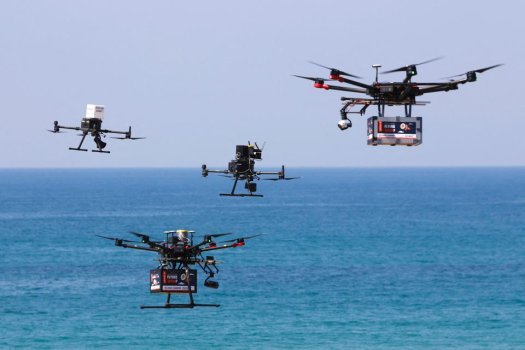K
Kathleen Martin
Guest
A report issued last week takes aim at rules that have been holding back the burgeoning $58.4 billion commercial drone market. The much anticipated Unmanned Aircraft Systems (UAS) Beyond Visual Line of Sight (BVLOS) Aviation Rulemaking Committee (ARC) Final Report recommends an overhaul of existing regulations, and the creation of new ones, to enable industry scalability.
Current rules require commercial drone operators to fly their aircraft within their visual line of sight. They also limit remote pilots to operating one drone at a time. In practice, this translates into shorter drone flights, monitored by visual observers either on foot or in chase cars.
To bolster efficiencies, businesses must obtain time-consuming and rarely granted waivers. Since 2018, the FAA has issued only 86 BVLOS waivers out of the almost four thousand total granted. Many of these apply in the context of research and development (R&D) programs, as opposed to real world applications.
Yet, over the past few years, the benefits of BVLOS drone operations have been repeatedly proven. Improved effectiveness, cost avoidance and increased safety rank high among them. Estimates indicate that BVLOS drone bridge inspections alone could save state departments of transportation $560 million annually. Drones alleviate the need for dangerous manual high-altitude operations that employ heavy and accident-prone ground vehicles. Manual inspections shut down highways for, on average, 8 hours at a time; a comparable drone inspection takes about an hour.
Recognizing the need for change, in June 2021, the FAA chartered the BVLOS ARC “to make recommendations to the FAA for performance-based regulatory requirements to normalize safe, scalable, economically viable, and environmentally advantageous UAS BVLOS operations that are not under positive air traffic control (ATC).”
The ARC membership list reads like a who’s who of key stakeholders. Aviation leaders Airbus, Wing and Skydio made the cut. Special interest groups, such as the American Civil Liberties Union, Women in Aviation International and the African American Mayors Association had a seat at the table. State, local, tribal and territorial governments also provided representatives, including the high tech Choctaw Nation of Oklahoma (Previous Forbes coverage of the Choctaw Nation here).
Jon Damush, ARC member and CEO of Iris Automation, creators of Casia 360, the leading detect-and-avoid system for safe beyond visual line of sight (BVLOS) flight operations, explained, "The BVLOS ARC was an amazing compilation of the industry leaders from all corners of aviation, from new entrants to our industry to legacy household names to community advocacy groups and labor unions. The ARC was divided into several working groups. These groups were dynamic and active. A great deal of time and effort was put in by everyone involved.”
Continue reading: https://www.forbes.com/sites/dawnzoldi/2022/03/14/this-report-could-unleash-the-potential-of-commercial-drones/?sh=1ec81253f219
Current rules require commercial drone operators to fly their aircraft within their visual line of sight. They also limit remote pilots to operating one drone at a time. In practice, this translates into shorter drone flights, monitored by visual observers either on foot or in chase cars.
To bolster efficiencies, businesses must obtain time-consuming and rarely granted waivers. Since 2018, the FAA has issued only 86 BVLOS waivers out of the almost four thousand total granted. Many of these apply in the context of research and development (R&D) programs, as opposed to real world applications.
Yet, over the past few years, the benefits of BVLOS drone operations have been repeatedly proven. Improved effectiveness, cost avoidance and increased safety rank high among them. Estimates indicate that BVLOS drone bridge inspections alone could save state departments of transportation $560 million annually. Drones alleviate the need for dangerous manual high-altitude operations that employ heavy and accident-prone ground vehicles. Manual inspections shut down highways for, on average, 8 hours at a time; a comparable drone inspection takes about an hour.
Recognizing the need for change, in June 2021, the FAA chartered the BVLOS ARC “to make recommendations to the FAA for performance-based regulatory requirements to normalize safe, scalable, economically viable, and environmentally advantageous UAS BVLOS operations that are not under positive air traffic control (ATC).”
The ARC membership list reads like a who’s who of key stakeholders. Aviation leaders Airbus, Wing and Skydio made the cut. Special interest groups, such as the American Civil Liberties Union, Women in Aviation International and the African American Mayors Association had a seat at the table. State, local, tribal and territorial governments also provided representatives, including the high tech Choctaw Nation of Oklahoma (Previous Forbes coverage of the Choctaw Nation here).
Jon Damush, ARC member and CEO of Iris Automation, creators of Casia 360, the leading detect-and-avoid system for safe beyond visual line of sight (BVLOS) flight operations, explained, "The BVLOS ARC was an amazing compilation of the industry leaders from all corners of aviation, from new entrants to our industry to legacy household names to community advocacy groups and labor unions. The ARC was divided into several working groups. These groups were dynamic and active. A great deal of time and effort was put in by everyone involved.”
Continue reading: https://www.forbes.com/sites/dawnzoldi/2022/03/14/this-report-could-unleash-the-potential-of-commercial-drones/?sh=1ec81253f219

